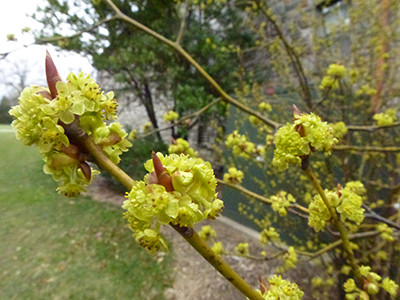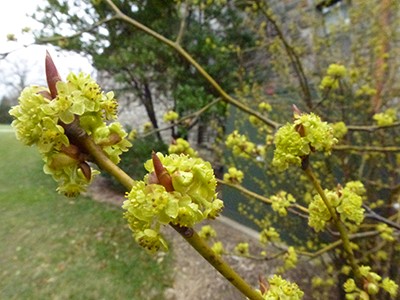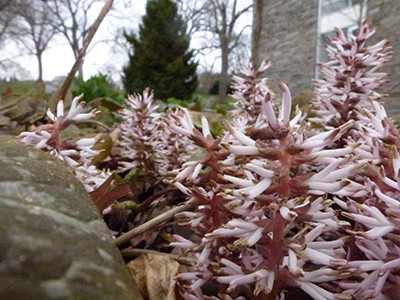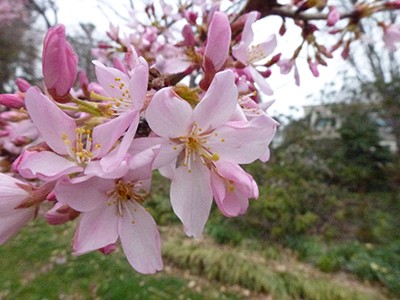
Plant of the Week: April 3
Between Alice Paul Residence Hall and the south side of Mertz Residence Hall, tastefully concealing some large building utility is the rare and interesting spicebush relative Lindera reflexa. Originally native to China, this species of Lindera is often dwarfed in significance by its relative Lindera angustifolia in common landscape use in the United States.
Though very similar to the native spicebush (Lindera benzoin) with its yellow flowers and leaf shape, L. reflexa has greenish-yellow semi-non-lenticellate bark, meaning it is mostly without the gas exchange openings that are commonly seen on the bark of woody plants. Also noteworthy are the terminal leaf buds in the winter which are covered in red-orange scales and are horn-shaped like thick versions of beech tree buds. photo credit: J. Bickel
Pachysandra procumbens
While some people cringe when they hear the word Pachysandra, others can’t seem to get enough of it. Personally I am not entirely sold on the Japanese Pachysandra terminalis that can be found ubiquitously throughout Philadelphia suburbia.
Pachysandra procumbens is a spurge native to the Allegheny region of the southeastern United States. It spreads rhizomatously, similar to its Japanese relative, though it is only marginally hardy to zone 7, so it doesn’t have that same evergreen appeal. The binomial comes from the greek roots “pachys” and “andro” meaning “thick” and “stamen,” respectively, referring to the peculiar thick waxy white stamens that protrude from the flower spikes like tiny bottlebrushes this time of year.
The specific epithet means “trailing,” likely in reference to the rhizomes. The flowers, when approached closely, emit a musty smell that isn’t terrible, but is not especially attractive (except perhaps to some pollinating animals/insects). A small stand can be found early in flower under the Malus at the southwest corner of Willets Residence Hall. photo credit: J. Bickel
Prunus ‘Beni Hoshi’
When the Cherry Border starts to bloom, I am finally confident that spring has begun. Near the north side of the border, close the steps leading to the Courtney Smith House, is a young cultivar of Prunus serrulata called ‘Beni Hoshi’.
Sources indicate that this translates to “Pink Stars” in Japanese.One realizes upon closer inspection that this is aptly named as the flowers are indeed a deep pink color and have five petals resembling the classic pentagram representation of a star. P. serrulata tends to be a medium to small tree, generally only reaching heights of 20 feet tall and wide in the crown. photo credit: J. Bickel








No Comments